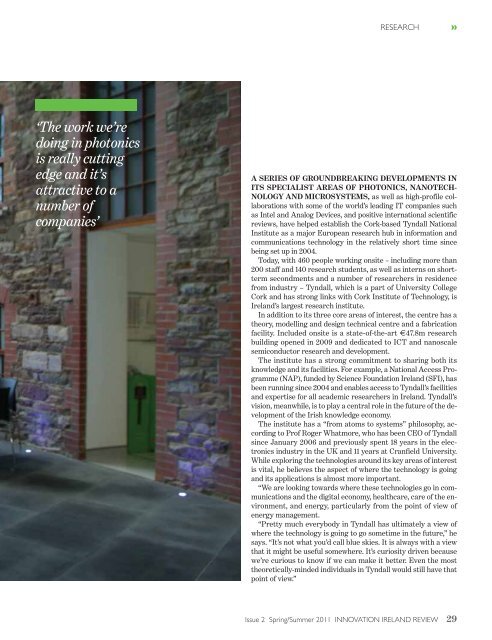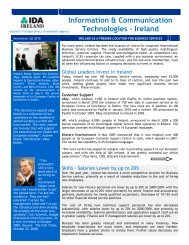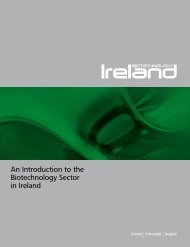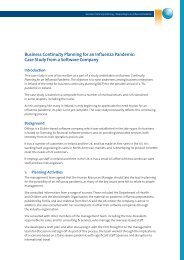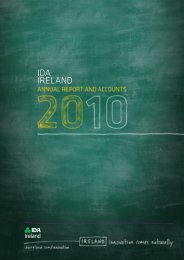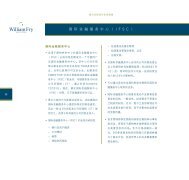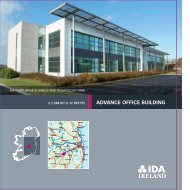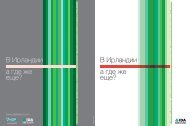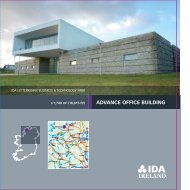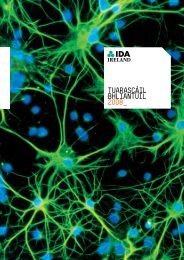Creativity - IDA Ireland
Creativity - IDA Ireland
Creativity - IDA Ireland
Create successful ePaper yourself
Turn your PDF publications into a flip-book with our unique Google optimized e-Paper software.
RESEARCH »<br />
‘The work we’re<br />
doing in photonics<br />
is really cutting<br />
edge and it’s<br />
attractive to a<br />
number of<br />
companies’<br />
A SERIES OF GROUNDBREAKING DEVELOPMENTS IN<br />
ITS SPECIALIST AREAS OF PHOTONICS, NANOTECH-<br />
NOLOGY AND MICROSYSTEMS, as well as high-profile collaborations<br />
with some of the world’s leading IT companies such<br />
as Intel and Analog Devices, and positive international scientific<br />
reviews, have helped establish the Cork-based Tyndall National<br />
Institute as a major European research hub in information and<br />
communications technology in the relatively short time since<br />
being set up in 2004.<br />
Today, with 460 people working onsite – including more than<br />
200 staff and 140 research students, as well as interns on shortterm<br />
secondments and a number of researchers in residence<br />
from industry – Tyndall, which is a part of University College<br />
Cork and has strong links with Cork Institute of Technology, is<br />
<strong>Ireland</strong>’s largest research institute.<br />
In addition to its three core areas of interest, the centre has a<br />
theory, modelling and design technical centre and a fabrication<br />
facility. Included onsite is a state-of-the-art €47.8m research<br />
building opened in 2009 and dedicated to ICT and nanoscale<br />
semiconductor research and development.<br />
The institute has a strong commitment to sharing both its<br />
knowledge and its facilities. For example, a National Access Programme<br />
(NAP), funded by Science Foundation <strong>Ireland</strong> (SFI), has<br />
been running since 2004 and enables access to Tyndall’s facilities<br />
and expertise for all academic researchers in <strong>Ireland</strong>. Tyndall’s<br />
vision, meanwhile, is to play a central role in the future of the development<br />
of the Irish knowledge economy.<br />
The institute has a “from atoms to systems” philosophy, according<br />
to Prof Roger Whatmore, who has been CEO of Tyndall<br />
since January 2006 and previously spent 18 years in the electronics<br />
industry in the UK and 11 years at Cranfield University.<br />
While exploring the technologies around its key areas of interest<br />
is vital, he believes the aspect of where the technology is going<br />
and its applications is almost more important.<br />
“We are looking towards where these technologies go in communications<br />
and the digital economy, healthcare, care of the environment,<br />
and energy, particularly from the point of view of<br />
energy management.<br />
“Pretty much everybody in Tyndall has ultimately a view of<br />
where the technology is going to go sometime in the future,” he<br />
says. “It’s not what you’d call blue skies. It is always with a view<br />
that it might be useful somewhere. It’s curiosity driven because<br />
we’re curious to know if we can make it better. Even the most<br />
theoretically-minded individuals in Tyndall would still have that<br />
point of view.”<br />
Issue 2 Spring/Summer 2011 INNOVATION IRELAND REVIEW 29


